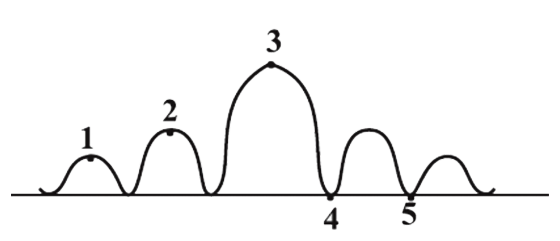State Huygen's principle. Show, with the help of s suitable diagram, how this principle is used to obtain the diffraction pattern by a single-slit.
Draw a plot of intensity distribution and explain clearly why the secondary maxima become weaker with increasing order (n) of the secondary maxima.
Diffraction of light (plane wavefront) from a single slit: As shown in figure when a plane wavefront WW. is incident normally on a narrow single-slit AB, each point on unblocked portion ADB of wavefront sends out secondary wavelets in all the directions. for secondary wavelets meeting at symmetrical central point O on the screen, the path difference betweenn wave is zero and hence the secondary waves reinforce each other giving rise to central maximum at point O. consider secondary waves travelling in a direction making an angle θ with DO and reaching the screen at point P. obviously, path difference betwee extreme secondary waves reaching P from A and B.
Δ=BC=ABsinθ=asinθ.
If this path difference asinθ=λ, then point P will have minimum intensity. in this situation, wavefront may be supposed to consist of two equal halves (known as half period elements) AD and DB and for every point on AD there will be a corresponding point on DB having a path difference λ2. consequently, they nullify effect of each other and point P behaves as first secondary minimum.
In general, if path difference asinθn=nλ, where n=1,2,3, . . , then we have nth secondary minima corresponding to that angle of diffraction θn, because then the wavefront AB is divided into an even number of half period elements and effect of all odd numbered half period elements is nullified by even numbered half period elements.

However, if for some point P1 on the secondary waves BP1 and AP1 differ in path by 3λ2, then point P1 will be the position of first secondary maxima. because in this situation, wavefront AB may be divided into three equal parts such that path difference between corresponding points on first and second parts will be λ2 and they will nullify. but secondary waves from third part remain as such and give rise to first secondary maxima, whose intensity will be much less than that of central maxima.
In general, if path difference asinθn=(2n+1)λ2, where n=1,2,3, . . , then we have nth secondary maxima corresponding to these angles.
Related Playlists
- BOOK - U-LIKE SERIESCHAPTER - WAVE OPTICSEXERCISE - SELF ASSESSMENT TEST SECTION A (MULTIPLE CHOICE QUESTIONS)6videos
WAVE OPTICS
- BOOK - U-LIKE SERIESCHAPTER - WAVE OPTICSEXERCISE - SELF ASSESSMENT TEST SECTION A (FILL IN THE BLANKS)2videos
WAVE OPTICS
- BOOK - U-LIKE SERIESCHAPTER - WAVE OPTICSEXERCISE - LONG ANSWER QUESTIONS-I31videos
WAVE OPTICS
- BOOK - U-LIKE SERIESCHAPTER - SEMICONDUCTOR ELECTRONICS : MATERIALS, DEVICES AND SIMPLE CIRCUITSEXERCISE - SECTION B1videos
SEMICONDUCTOR ELECTRONICS : MATERIALS, DEVICES AND SIMPLE CIRCUITS
Similar Questions
The condition for obtaining secondary maxima in the diffraction pattern due to single slit is
View SolutionThe condition for obtaining secondary maxima in the diffraction pattern due to single slit is
View SolutionThe angular width of the central maximum of the diffraction patternn in a single slit (of width a) experiment, with λ as the wavelenth of light, is
View SolutionState the working principle of a potentiometer. With the help of the circuit diagram explain how a potentiometer is used to compare the emfs of two primary cells. Obtain the required expression used for comparing the emfs.
View SolutionIn a single-slit diffraction experiment, light of wavelength λ illuminates the slit of width 'a' and the diffraction pattern is observed on a screen.
(a) Show the intensity distribution in the pattern with the angular position θ.
(b) How are the intensity and angular width of central maxima affected when
(i) width of slit is increased, and
(ii) separation between slit and screen is decreased ?View SolutionFind the intensities of the first three secondary maxima in the single-slit diffraction pattern, measured relative to the intensity of the central maximum
View Solution(a) Using Huygen's principle draw a diagram to whow propagation of a front originating from a monochrmatic source.
(b) Desctibe diffraction of light due to a single slit. Explain formation of a pattern of fringes obtained on the screen and plot showing variation of intensity with angle θ in single slit diffraction.View SolutionLight of wavelength 6 , 000 Å falls on a single slit and diffracts. It is observed that the first maximum in diffraction pattern subtends an angle of 45°, calculate the angular separation between central maxima and secondary maxima of first order in observed diffraction pattern.
View Solution(a) State the working principle of a potentiometer. With the help of the circuit diagram, explain how a potentiometer is used to compare the emfs of two primary cells. Obtain the required expression used for comparing the emfs.
(b) Write two possible causes for one sided deflection in a potentiometer experiment.View SolutionThe diffraction pattern of a single slit is shown in the figure. The point at which the path difference of the extreme rays is two times the wavelength is
 View Solution
View Solution

